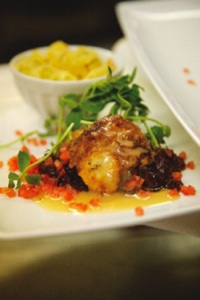By Stephen Beaumont and Brian Morin
Serves 8
Ingredients:
5 lbs (2.25 kg) veal cheeks
Pinch salt and freshly ground black pepper
1/2 cup (125 mL) oil
6 sprigs fresh thyme, leaves removed and stems discarded
2 sprigs fresh rosemary, leaves removed and stems discarded
2 to 3 juniper berries
3 cloves garlic
2 cups (500 mL) light to medium bodied brown ale
1 tbsp (15 mL) red wine vinegar
4 1/2 cups (1.125 L) veal stock
Instructions:
Season veal cheeks well with salt and pepper. Preheat oven to 275 degrees.
In a large, deep, heavy-bottomed frying pan over medium-high heat, heat oil until very hot but not smoking. Add veal cheeks and brown on all sides.
Remove meat from the pan and drain excess oil. Reduce heat to medium and return cheeks to the pan along with rosemary, thyme, juniper berries, garlic, beer and vinegar.
In a separate medium saucepan, bring veal stock to a boil and pour over cheeks.
Cover the pan with a lid or foil and continue to cook in the oven for six hours or until a knife passes easily through the cheeks.